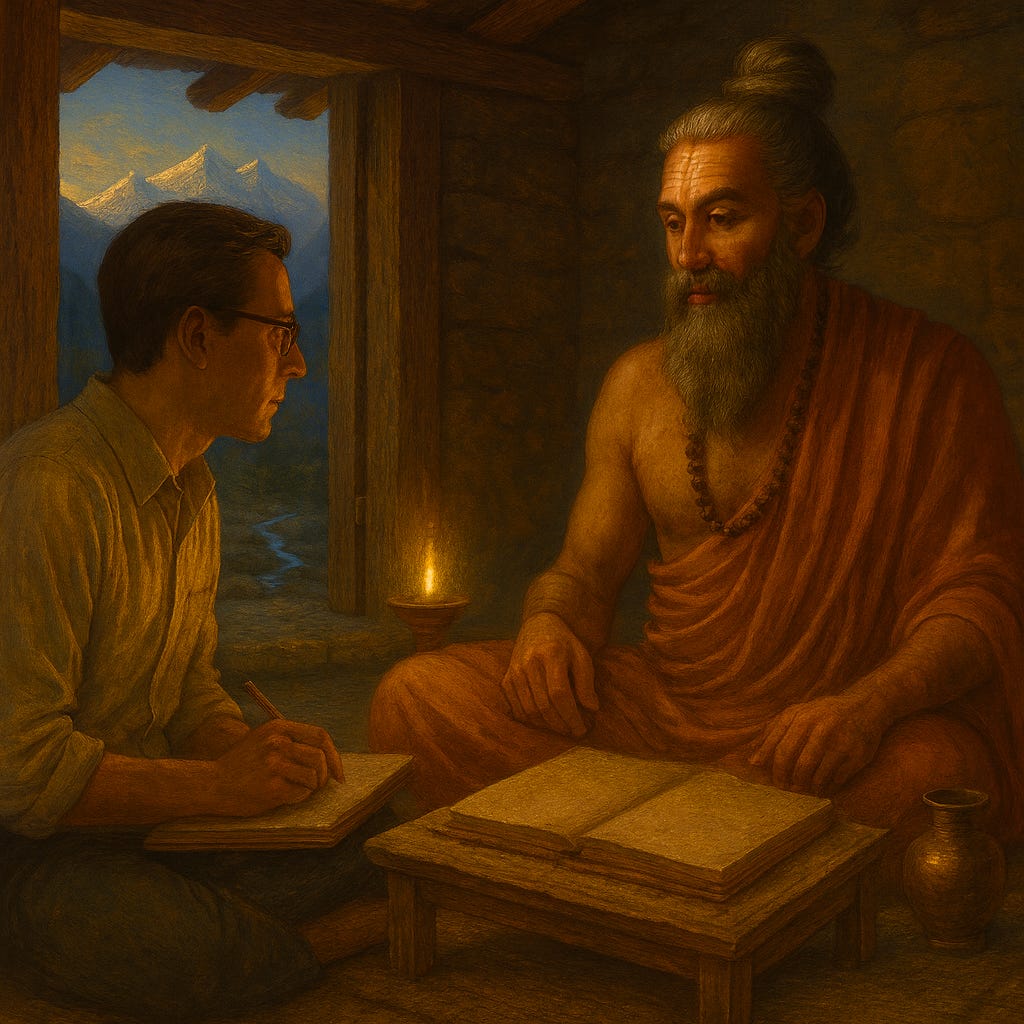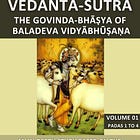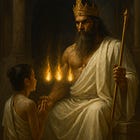The Vedanta-sutra in prose. A scientist meets Vyasadeva
This is the first pāda, or section of the Vedanta-sutra, rendered as a short dialogue between Vyasadeva and a student, where the questions of student are directly answered by the words of the sutras.
The Vedanta-sutra is written in the form of short sutras that at first appear to have little to do with one another. However, as we study the text, the connection between the sutras becomes clearer, and the whole book emerges as a great dialogue, with arguments and counter-arguments that reveal the ultimate meaning of the scriptures.
This is the first pāda, or section of the Vedanta-sutra, rendered as a short dialogue between Vyasadeva and a student, where the questions of student are directly answered by the words of the sutras.
Of course, the meaning of the Vedanta-sutra goes much beyond what can be expressed here, but that is the maximum that can be expressed in a few paragraphs. If you are interested in going deeper, you can check the full commentary that is being published here:
Now, the dialogue:
Vyasadeva speaks: "Now, therefore, having come to the human form of life and attained education and other facilities, it is time to enquire about Brahman, the Absolute Truth."
- What is this Brahman whe should inquire about?
"Brahman, the Supreme Personality of Godhead, is He, from whom everything emanates."
- How can we know about Him?
"He, the Absolute Truth, cannot be known merely by reasoning; He is known only through the śāstras.”
- The Vedas speak about many topics, such as astronomy, architecture, and auspicious ceremonies for elevation to heaven...
"The goal of the Vedas is not fruitive activity. On the contrary, Lord Viṣṇu is the sole topic discussed. This is the agreement of all Vedic scriptures."
- You mention that the Vedas describe many topics, but the goal of all descriptions is to elevate one to the worship of Lord Viṣnu. This seems reasonable. However, some say Brahman is impersonal and qualityless, and therefore can't be described by words. They say that the Brahman the Vedas describe is a manifestation of the three modes, still part of the material nature. This leads me to believe that the Vedas do not ultimately reveal Brahman.
“Brahman is not indescribable by words, for it is seen that He is vividly described in the scriptures. If one argues that the Brahman described in the scriptures is saguna Brahman (a manifestation covered by the material modes), I say no, because Brahman is described in the Vedas as ātmā, the Supreme Self.
The Brahman described in the scriptures is the transcendental Supreme Lord, not a temporary manifestation of the material modes, because the scriptures teach that His devotees attain liberation. Furthermore, there is no statement in the Vedas that He should be discarded in favor of something higher.
The Supreme Lord is not a manifestation of the material modes, also because He merges into Himself and not into something else.
If it is suggested that there are two types of Brahman, I say it is not so, because the scriptures uniformly describe only one transcendental Brahman. He has no material qualities; this is directly stated throughout the Vedic literature.”
- The Upaniṣads do not appear to consistently describe a supreme, transcendental Brahman. In some places they seem to glorify the jīva (the individual soul), in others the element ether (ākāśa), sometimes the sun-god or another deva, sometimes vital air (prāṇa), or even common light (jyotiḥ). If these lower manifestations are presented as the ultimate, how can we be certain that the Vedas are actually teaching about a supreme Brahman at all?
"The ānanda-maya puruṣa [described in the Taittirīya Upaniṣad] is the Supreme Lord; this is established by repeated statements. If it is argued that the Supreme Brahman cannot be the ānanda-maya because the word implies transformation, I say it is not so, because the suffix -maya denotes abundance, not modification.
The ānanda-maya is not the jīva, for the scriptures declare that He is the source of bliss for others. Moreover, Brahman is described in the mantra section of the same Upaniṣad as the ānanda-maya person. The mantra does not describe the jīva; such an interpretation is untenable in the context. The Lord and the jīva are distinct, as revealed by scriptural statements declaring their difference.
Nor can the ānanda-maya be pradhāna, for the passage attributes will and desire to Him, qualities absent in unconscious matter. The scriptures teach that union with the ānanda-maya puruṣa grants fearlessness to the soul, confirming that He is no other than the Supreme Lord."
“The person within the Sun and the eye is the Lord, because the passage [of the Chāndogya Upaniṣad] describes His qualities. He is different from the demigod because statements in the Vedic scriptures describe the difference between the demigod in the Sun and the Lord in the Sun. For the same reason, the word prāṇa also denotes Brahman."
"Because the light (jyoti) is described as having feet, it must refer to the Supreme Brahman. If it is suggested that the feet refer to the gāyatrī meter, mentioned in the previous passage, I say it is not so. The meter is taught to help one fix the mind on Brahman. Therefore, jyoti refers to Brahman. This is the correct understanding of the scripture.
Because the passage beginning with "bhūta" defines Gāyatrī as divided into four parts (all living beings, the universe, body, and heart) that only Brahman can have, Gāyatrī in that passage must refer to Brahman.
To argue that the two passages describe two different things is not a valid objection. There is no contradiction."
“In the same way, the word prāna [in the Kauṣītaki Upanisad] also refers to Brahman, and not to the jīva. This is clear from the context. If one argues that the speaker (Indra) refers to himself, I say it is not so. There is an abundance of passages connected with the Supreme Personality of Godhead in this section of the text. Indra’s declaration of identity with Brahman is in accordance with scripture, just as in the case of the sage Vāmadeva.
If one further claims that the word prāna means simultaneously the jīva, the vital breath, and Brahman, this too is not correct. If we accept that view, we end up with three different objects for meditation, which is illogical in the context of the scriptures. The Upaniṣads describe Brahman as the foundation and essence of both jīva and prāṇa (āśritatvāt), so they are not independent entities for separate worship. They are dependent on Brahman. Therefore, in this context, prāṇa must be understood to denote Brahman alone.”
If you read this article to the end, give it a like. This makes Substack recommend it to more people.
Read also:






